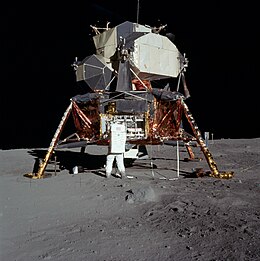
Back Módulo lunar Eagle Spanish Eagle (module lunaire) French Eagle holdkomp Hungarian Лунный модуль «Орёл» Russian Kartal Ay Modülü Turkish
| Eagle | |
|---|---|
| Part of Apollo 11 | |
 | |
| Type | Lunar module |
| Class | Apollo Lunar Module |
| Manufacturer | Grumman |
| Specifications | |
| Launch mass | 33,294.5 lb (15,102.1 kg)[1] |
| History | |
| Deployed | July 20, 1969 |
| Fate |
|
 |
| Part of a series on |
| Apollo 11 |
|---|
|
Lunar Module Eagle (LM-5) is the spacecraft that served as the crewed lunar lander of Apollo 11, which was the first mission to land humans on the Moon. It was named after the bald eagle, which was featured prominently on the mission insignia. It flew from Earth to lunar orbit on the command module Columbia, and then was flown to the Moon on July 20, 1969, by astronaut Neil Armstrong with navigational assistance from Buzz Aldrin. Eagle's landing created Tranquility Base, named by Armstrong and Aldrin and first announced upon the module's touchdown.
The name of the craft gave rise to the phrase "The Eagle has landed", the words Armstrong said upon Eagle's touchdown.[2]
- ^ "Selected Mission Weights". history.nasa.gov. Retrieved September 24, 2020.
- ^ Cresswell, J. (2007). The Cat's Pyjamas: The Penguin Book of Clichés. Penguin Books Limited. p. 427. ISBN 978-0-14-102516-2. Retrieved October 22, 2021.